Asia Pacific Electric Vehicle Battery Manufacturing Market Size
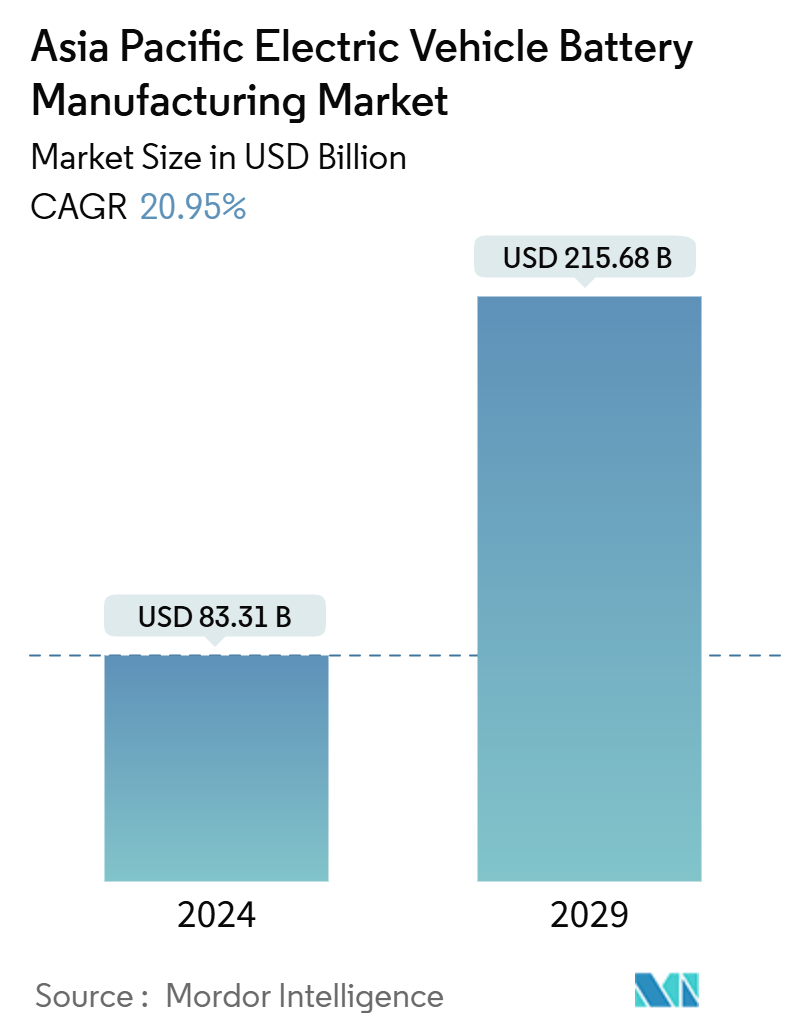
| Study Period | 2019 - 2029 |
| Base Year For Estimation | 2023 |
| Market Size (2024) | USD 83.31 Billion |
| Market Size (2029) | USD 215.68 Billion |
| CAGR (2024 - 2029) | 20.95 % |
| Market Concentration | Low |
Major Players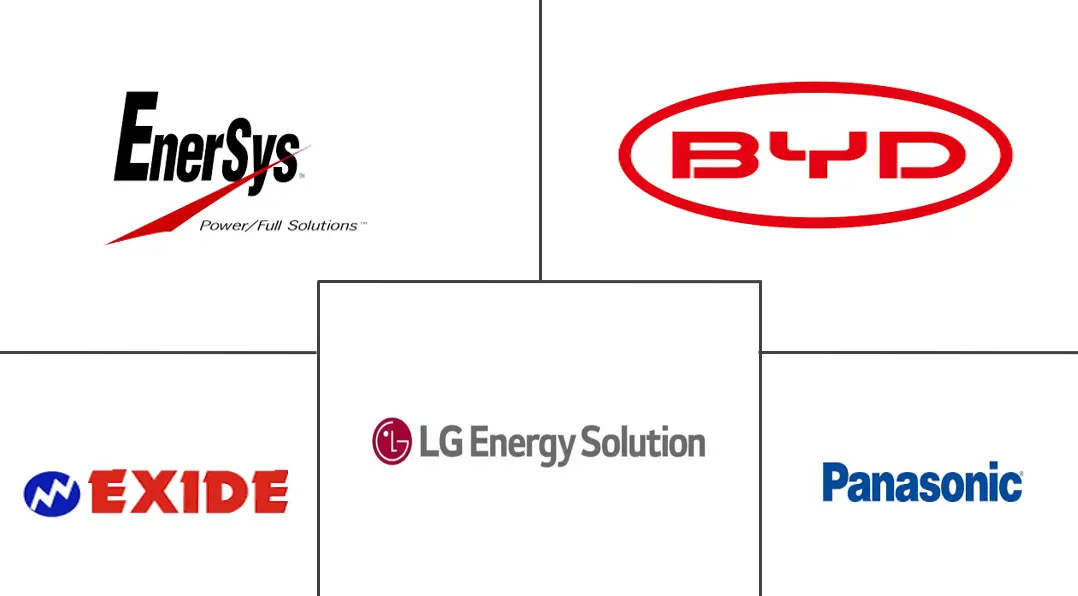
*Disclaimer: Major Players sorted in no particular order |
Asia Pacific Electric Vehicle Battery Manufacturing Market Analysis
The Asia Pacific Electric Vehicle Battery Manufacturing Market size is estimated at USD 83.31 billion in 2024, and is expected to reach USD 215.68 billion by 2029, at a CAGR of 20.95% during the forecast period (2024-2029).
- Over the medium term, rising investments to enhance the battery production capacity and the decline in the cost of battery raw materials are expected to drive the demand for electric vehicle battery manufacturing during the forecast period.
- On the other hand, increasing sales of conventional vehicles due to their high reliability is expected to have a negative impact on the EV battery market during the forecast period.
- Nevertheless, the long-term ambitious targets for electric vehicles, such as scaling up production capacity, enhancing technological advancements, and reducing costs, are expected to create significant opportunities for the electric vehicle battery manufacturing market in the near future.
- India is the fastest-growing region in Asia Pacific's electric vehicle battery manufacturing market during the forecast period due to the rising electric vehicle adoption.
Asia Pacific Electric Vehicle Battery Manufacturing Market Trends
Lithium-Ion Battery Type Dominate the Market
- Lithium-ion (Li-ion) batteries have revolutionized the electric vehicle (EV) market, driving innovations in battery production. Their key attributes, such as high energy density, long cycle life, and swift charging, make them the preferred choice for today's EVs.
- Moreover, lithium-ion rechargeable batteries surpass other technologies due to their excellent capacity-to-weight ratio. Although they tend to be more expensive than alternatives, major players in the market are boosting R&D investments and ramping up production, heightening competition and leading to price reductions.
- Despite rising average battery pack prices for EVs and battery energy storage systems (BESS), 2023 witnessed a significant drop in battery prices to USD 139/kWh, a 13% decline. Projections suggest this downward trajectory will persist, with prices anticipated to reach USD 113/kWh by 2025 and further plummet to USD 80/kWh by 2030, driven by relentless technological and manufacturing progress.
- In the Asia Pacific region, governments are implementing policies and incentives to promote electric vehicle (EV) adoption and stimulate Lithium-ion battery production growth. By prioritizing research and development, these governments seek to pinpoint cost-effective and readily available materials as substitutes for more expensive and scarce ones, such as cobalt. This strategy not only curtails manufacturing costs but also ensures a more sustainable supply chain.
- For example, in May 2024, China is set to invest approximately 6 billion yuan (USD 845 million) into pioneering next-generation battery technology for electric vehicles (EVs), encompassing hybrid models. ASSBs, a cutting-edge technology, enhance traditional lithium-ion batteries (LIBs) with solid components. They boast a reduced risk of fire or explosion compared to conventional batteries and offer superior energy density. Such innovations are poised to boost the demand for advanced lithium-ion batteries in the coming years, positively influencing EV battery manufacturing in the region.
- Furthermore, the surging demand for Li-ion batteries has catalyzed the establishment of large-scale production facilities, dubbed Gigafactories. These specialized facilities are engineered to produce battery cells en masse, ensuring they meet the escalating demand from electric vehicles (EVs). Major companies in the region are launching multiple projects to strengthen their lithium-ion battery manufacturing, anticipating a notable uptick in EV battery demand soon.
- For instance, in February 2024, BMW unveiled plans for a new battery factory in Rayong, Thailand, aiming to bolster the nation's battery supply chains. The company envisions Thailand as its primary export hub for EV batteries throughout the Asia Pacific, further strengthening the region's lithium-ion battery supply. Such initiatives are set to accelerate the country's battery production in the upcoming years.
- Consequently, these endeavors are poised to amplify lithium-ion battery production and substantially boost EV battery manufacturing capacity in the forecast period.
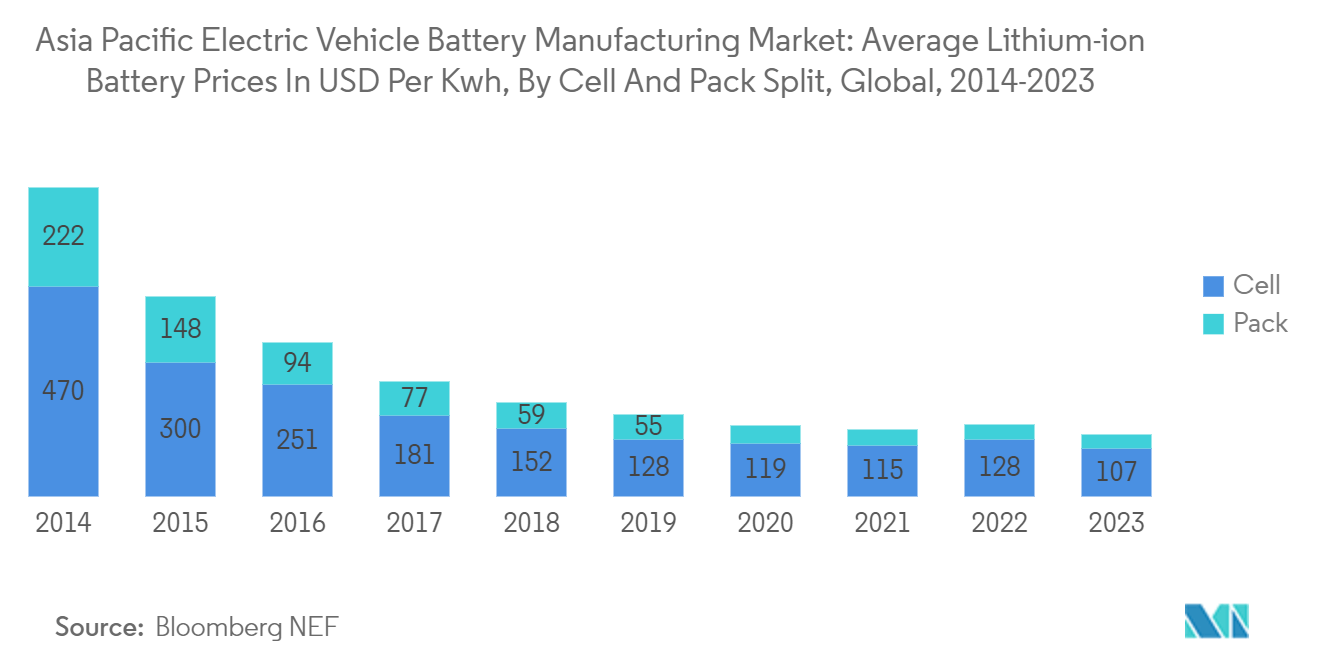
India to Witness Significant Growth
- India's electric vehicle (EV) battery manufacturing market is rapidly expanding as the nation embraces greener mobility solutions. This growth is fueled by government initiatives, a surging demand for electric vehicles, and substantial investments from both domestic and international players.
- As India pivots towards clean energy, the emphasis on electric vehicles has become paramount for numerous companies. EV sales in the region have skyrocketed. For instance, the International Energy Agency (IEA) reported that in 2023, electric vehicle sales reached 82,000 units, marking a 70.8% increase from 2022 and a staggering 119-fold jump since 2019. With the government recently launching multiple projects and initiatives, EV sales are poised for further significant growth.
- India has seen a wave of investments in EV battery manufacturing, both from domestic entities and international firms. These investments aim to strengthen the nation's electric vehicle infrastructure, lessen reliance on fossil fuels, and champion sustainable transportation. Bolstered by supportive government policies and incentives, India is carving out a prominent position in the global EV landscape.
- For example, in July 2024, Ola Electric unveiled a USD 100 million investment for the first phase of its gigafactory in Tamil Nadu, India. This facility will produce indigenous lithium-ion batteries. The company plans to transition to its battery cells for its electric vehicles by early next year, moving away from current imports from Korea and China. Such moves are set to ramp up battery production nationwide in the coming years.
- Additionally, the Indian government has rolled out initiatives to promote electric vehicle (EV) adoption and stimulate local battery manufacturing. These measures encompass subsidies for EV purchasers, tax breaks for manufacturers, and bolstered investments in charging infrastructure.
- As an illustration, the Indian government, in 2023, set ambitious targets: by 2030, they aim for EVs to constitute 30% of private car sales, 70% of commercial vehicles, and 80% of two and three-wheelers. Furthermore, the government is offering subsidy incentives ranging from INR 10,000 per kWh (USD 120) to INR 15,000 per kWh (USD 180). Such initiatives are poised to not only boost EV production and demand but also amplify the need for battery manufacturing in the region during the forecast period.
- Consequently, these projects and initiatives are set to bolster EV demand and, in turn, significantly elevate the need for EV battery manufacturing in the coming years.
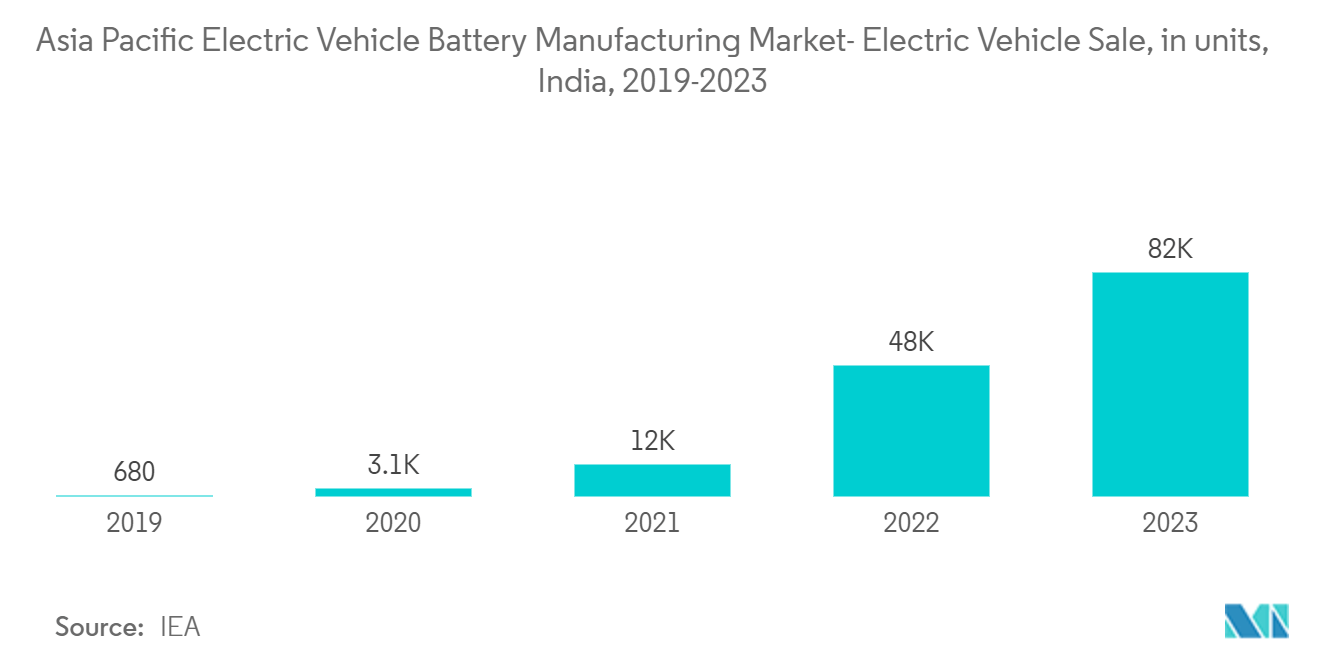
Asia Pacific Electric Vehicle Battery Manufacturing Industry Overview
Asia Pacific's electric vehicle battery manufacturing market is semi-fragmented. Some of the key players (not in particular order) are BYD Company Ltd, LG Energy Solution, Exide Industries Ltd, EnerSys, and Panasonic Holdings Corporation, among others.
Asia Pacific Electric Vehicle Battery Manufacturing Market Leaders
-
Panasonic Holdings Corporation
-
BYD Company Ltd
-
EnerSys
-
Exide Industries Ltd
-
LG Energy Solution
*Disclaimer: Major Players sorted in no particular order
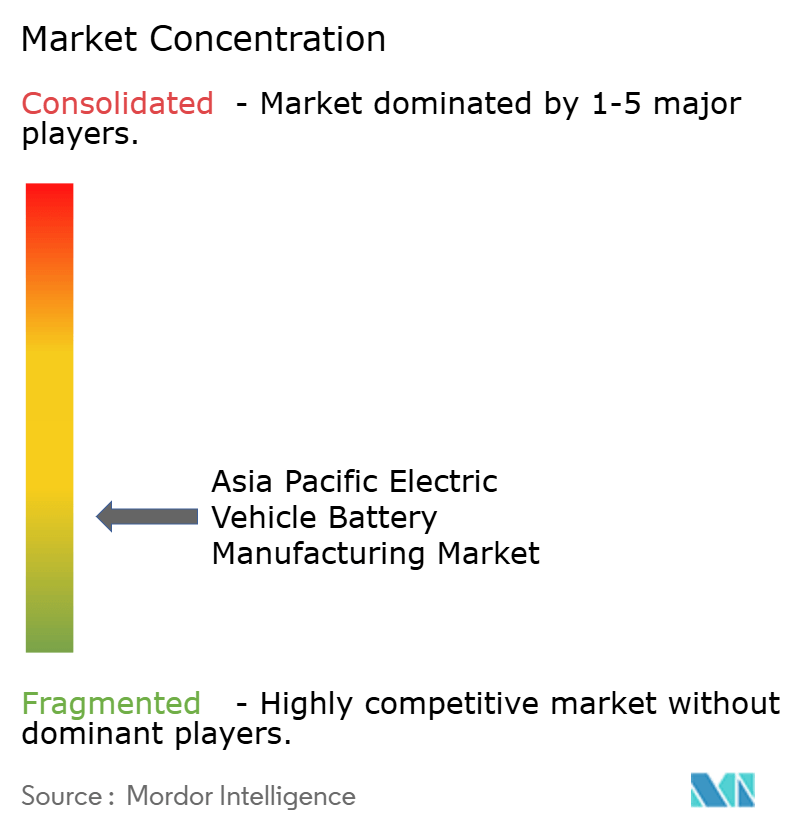
Asia Pacific Electric Vehicle Battery Manufacturing Market News
- May 2024: The Australian government has launched the National Battery Strategy, aiming to strengthen the nation's foothold in battery manufacturing, especially for electric vehicles (EVs). To propel this initiative, the government plans to inject around USD 532 million in financial incentives over the next few years.
- November 2023: SK On Co., a manufacturer of electric vehicle batteries, has partnered with BASF SE, a producer of battery materials. Together, they aim to develop cutting-edge materials for lithium-ion batteries, with a primary focus on North America and the Asia-Pacific regions. This collaboration serves as a strategic maneuver to enhance their competitive advantage, particularly given the slowing growth in the eco-friendly automobile sector.
Asia Pacific Electric Vehicle Battery Manufacturing Market Report - Table of Contents
1. INTRODUCTION
1.1 Scope of the Study
1.2 Market Definition
1.3 Study Assumptions
2. EXECUTIVE SUMMARY
3. RESEARCH METHODOLOGY
4. MARKET OVERVIEW
4.1 Introduction
4.2 Market Size and Demand Forecast in USD, till 2029
4.3 Recent Trends and Developments
4.4 Government Policies and Regulations
4.5 Market Dynamics
4.5.1 Drivers
4.5.1.1 Investments to Enhance the battery production capacity
4.5.1.2 Decline in cost of battery raw materials
4.5.2 Restraints
4.5.2.1 High reliability on Conventional Vehicle
4.6 Supply Chain Analysis
4.7 Industry Attractiveness - Porter's Five Forces Analysis
4.7.1 Bargaining Power of Suppliers
4.7.2 Bargaining Power of Consumers
4.7.3 Threat of New Entrants
4.7.4 Threat of Substitutes Products and Services
4.7.5 Intensity of Competitive Rivalry
4.8 Investment Analysis
5. MARKET SEGMENTATION
5.1 Battery
5.1.1 Lithium-ion
5.1.2 Lead-Acid
5.1.3 Nickel Metal Hydride Battery
5.1.4 Others
5.2 Battery Form
5.2.1 Prismatic
5.2.2 Pouch
5.2.3 Cylindrical
5.3 Vehicle
5.3.1 Passenger Cars
5.3.2 Commercial Vehicles
5.3.3 Others
5.4 Propulsion
5.4.1 Battery Electric Vehicle
5.4.2 Hybrid Electric Vehicle
5.4.3 Plug-in Hybrid Electric Vehicle
5.5 Geography
5.5.1 China
5.5.2 India
5.5.3 Australia
5.5.4 Malaysia
5.5.5 Thailand
5.5.6 Indonesia
5.5.7 Vietnam
5.5.8 Rest of Asia-Pacific
6. COMPETITIVE LANDSCAPE
6.1 Mergers and Acquisitions, Joint Ventures, Collaborations, and Agreements
6.2 Strategies Adopted by Leading Players
6.3 Company Profiles
6.3.1 BYD Co. Ltd
6.3.2 Panasonic Corporation
6.3.3 LG Energy Solution
6.3.4 EnerSys
6.3.5 Exide Industries
6.3.6 Contemporary Amperex Technology Co. Limited
6.3.7 Tianjin Lishen Battery Joint-Stock Co., Ltd.
6.3.8 Samsung SDI
6.3.9 SK Innovation Co., Ltd.
6.3.10 Envision AESC
6.3.11 Gotion High tech Co Ltd
- *List Not Exhaustive
6.4 List of Other Prominent Companies
6.5 Market Ranking Analysis
7. MARKET OPPORTUNITIES AND FUTURE TRENDS
7.1 Long-term ambitious targets for electric vehicles
Asia Pacific Electric Vehicle Battery Manufacturing Industry Segmentation
EV Battery Manufacturing refers to producing batteries specifically designed for electric vehicles (EVs). This involves several stages, including the sourcing of raw materials, the production of battery cells, and the assembly of these cells into battery packs that can be integrated into EVs.
Asia Pacific's electric vehicle battery manufacturing market is Segmented by Battery Type, Battery Form, Vehicle Type, Propulsion Type, and Geography. By battery type, the market is segmented into Lithium-Ion Battery, Lead-Acid Battery, Nickel Metal Hydride Battery, and Others. By battery form, the market is segmented into Prismatic, Pouch, and Cylindrical. By vehicles, the market is segmented into Passenger Cars, Commercial Vehicles, and Others. By propulsion, the market is segmented into Battery Electric Vehicles, Hybrid Electric Vehicles, and Plug-In Hybrid Electric Vehicles. The report also covers the market size and forecasts for Asia Pacific's electric vehicle battery manufacturing market across major countries. The Report Offers the Market Size and Forecasts in Revenue (USD) for all the Above.
| Battery | |
| Lithium-ion | |
| Lead-Acid | |
| Nickel Metal Hydride Battery | |
| Others |
| Battery Form | |
| Prismatic | |
| Pouch | |
| Cylindrical |
| Vehicle | |
| Passenger Cars | |
| Commercial Vehicles | |
| Others |
| Propulsion | |
| Battery Electric Vehicle | |
| Hybrid Electric Vehicle | |
| Plug-in Hybrid Electric Vehicle |
| Geography | |
| China | |
| India | |
| Australia | |
| Malaysia | |
| Thailand | |
| Indonesia | |
| Vietnam | |
| Rest of Asia-Pacific |
Asia Pacific Electric Vehicle Battery Manufacturing Market Research Faqs
How big is the Asia Pacific Electric Vehicle Battery Manufacturing Market?
The Asia Pacific Electric Vehicle Battery Manufacturing Market size is expected to reach USD 83.31 billion in 2024 and grow at a CAGR of 20.95% to reach USD 215.68 billion by 2029.
What is the current Asia Pacific Electric Vehicle Battery Manufacturing Market size?
In 2024, the Asia Pacific Electric Vehicle Battery Manufacturing Market size is expected to reach USD 83.31 billion.
Who are the key players in Asia Pacific Electric Vehicle Battery Manufacturing Market?
Panasonic Holdings Corporation, BYD Company Ltd, EnerSys, Exide Industries Ltd and LG Energy Solution are the major companies operating in the Asia Pacific Electric Vehicle Battery Manufacturing Market.
What years does this Asia Pacific Electric Vehicle Battery Manufacturing Market cover, and what was the market size in 2023?
In 2023, the Asia Pacific Electric Vehicle Battery Manufacturing Market size was estimated at USD 65.86 billion. The report covers the Asia Pacific Electric Vehicle Battery Manufacturing Market historical market size for years: 2019, 2020, 2021, 2022 and 2023. The report also forecasts the Asia Pacific Electric Vehicle Battery Manufacturing Market size for years: 2024, 2025, 2026, 2027, 2028 and 2029.
Asia Pacific Electric Vehicle Battery Manufacturing Industry Report
Statistics for the 2024 Asia Pacific Electric Vehicle Battery Manufacturing market share, size and revenue growth rate, created by Mordor Intelligence™ Industry Reports. Asia Pacific Electric Vehicle Battery Manufacturing analysis includes a market forecast outlook for 2024 to 2029 and historical overview. Get a sample of this industry analysis as a free report PDF download.



